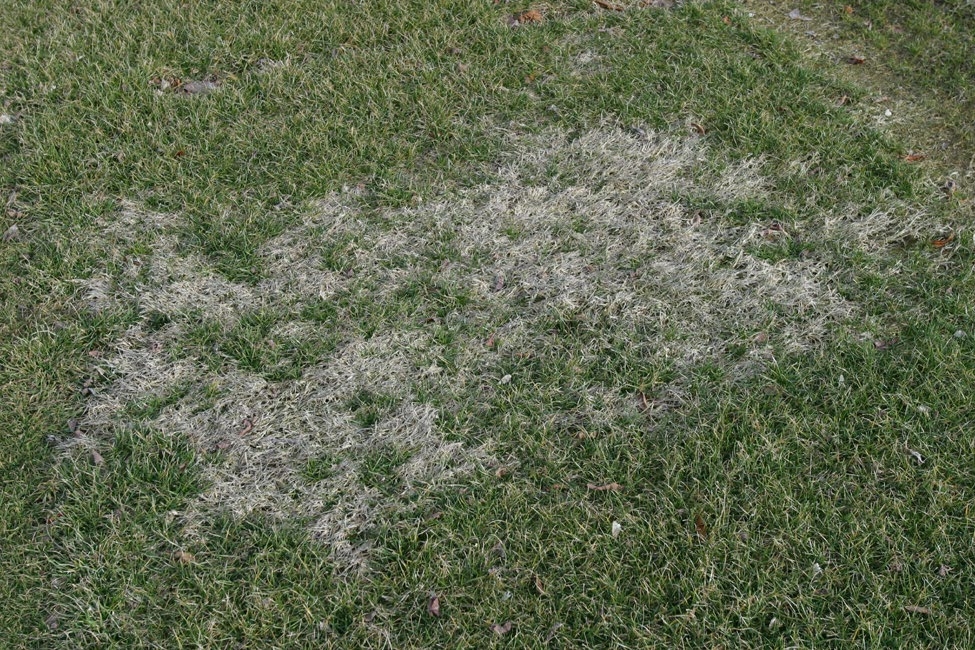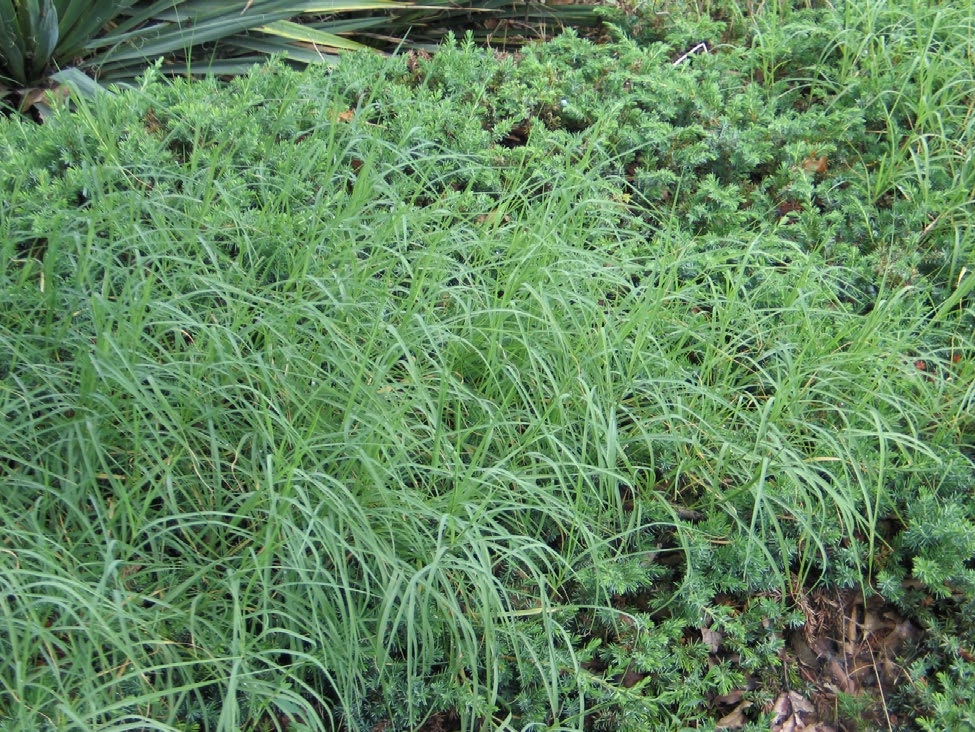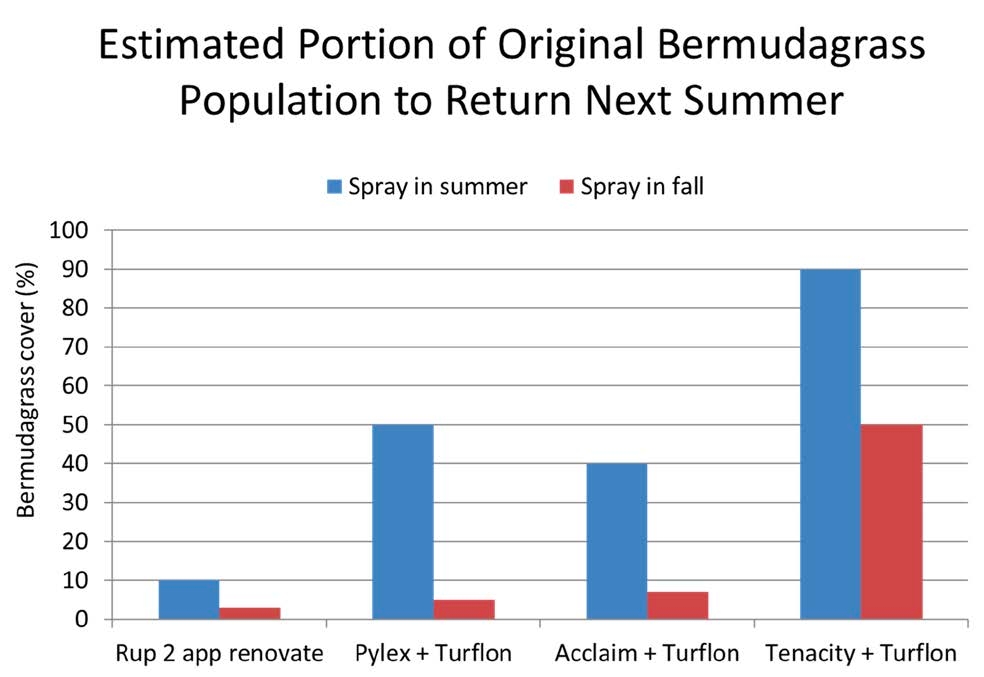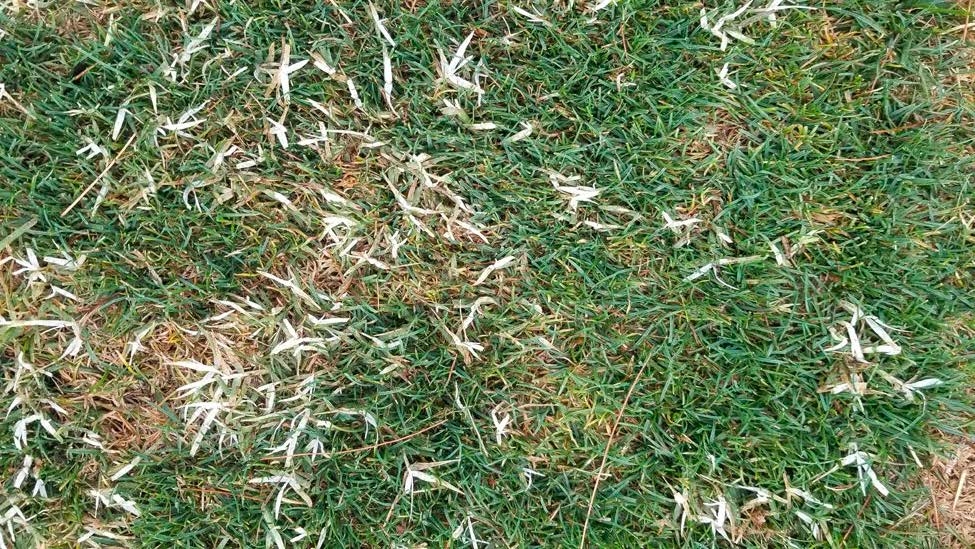Selective Bermudagrass Control for Lawns
ID
SPES-350NP
Introduction
Ahh, the nostalgia of the close cropped, well-manicured bermudagrass (Cynodon spp.) lawn. If you are from the South, thoughts of bermudagrass conjure images of pine needles, magnolias, and the sweet smell of Gardenias. However, when you reside in the transition zone, bermudagrass can soon lose its favor. Bermudagrass-contaminated cool-season turfgrass lawns will have distinct brown patches during the colder months of the year when the bermudagrass is fully dormant (Figure 1). The rapid growth rate of bermudagrass makes it a serious weed problem in ornamental beds and gardens (Figure 2). Even the common name of the grass tends to change as you approach the Mason-Dixon Line. What once was called “bermudagrass” and had a place among the prominent turfgrasses where professional golf events and collegiate and professional football games are hosted, is now called “wiregrass” with a lump in ones throat that is often hard to swallow.

Don’t misunderstand, there are improved cultivars of bermudagrass that are well adapted as lawn grasses in the transition zone (although they definitely can present the same levels or more of weed pressure as common wiregrass can). It is hard, though, to convince the citizens of the north of positive bermudagrass attributes when all-out war has been waged against the grass for so many years in their cool-season lawns. We find ourselves, once again, developing a publication with the sole purpose of driving bermudagrass back to the fiery depths of, well, from where it came.

The problem
Bermudagrass poses such problems in cool-season lawns for two main reasons: it is almost impossible to kill and it is almost impossible to kill. It survives most environments with less water, less nutrient, less fungicide, and less topsoil. About the only thing the grass can’t tolerate is less light and we will get to further discussion of that in a moment. Bermudagrass is a C4 grass meaning it has a method of metabolism in food production and water use efficiency that is far superior in hot weather than our C3 cool-season grasses. Plants can persist and spread as stolons (above ground stems) and rhizomes (below ground stems), and common types of bermudagrass also may spread by seed. It protects itself from threats by being able to gather nutrients and moisture over a vast network of conductive tissues, going dormant when needed to avoid extreme stress, and using adventurous stolons to “find new ground” and overcome competing vegetation. Yes, it is a pain and you already know that; let’s get to the part where we kill it.
Cultural control
Most extension recommendations will have that section on cultural control or nonchemical control, right? It is sort of like the appetizer that you eat while you wait for the “real meal” to be served. But listen to what I tell you. Bermudagrass can’t be controlled without the use of cultural methods. The best way to control bermudagrass is by raising the mowing height of cool-season grasses into the “jungle” range because bermudagrass can’t tolerate low light. Research has shown that tall fescue can completely kill bermudagrass at a mowing height of 4 inches without use of herbicides. Have you ever seen tall fescue that was really mown at 4 inches? It is a bit shaggy and mowers tend to leave tire tracks for a day or so but your fescue will love you for it. Your fescue will be so happy, it will give you darker green color, more drought resistance, more disease resistance, and of course, a barrier against weeds that is to die for – if you are a weed. Another way to know that your fescue loves you at a 4-inch mowing height is that it will continue to reach up and try to hug you. In other words, it grows really fast and must be mown more frequently. Cool-season turfgrass managed at the lower end of recommended mowing heights or less will reduce the effectiveness of herbicide controls for bermudagrass to such an extent that control is nearly impossible. You must maintain cool-season turfgrass at the upper end of recommended mowing heights if you intend to be successful at controlling bermudagrass.
Chemical control
For those who skipped straight to this section, please see the cultural control section for an important announcement. There are only a few herbicides that will harm bermudagrass more than tall fescue (the cool-season lawn of most importance in wiregrass contamination in the transition zone). And by the way, that is about as good as it gets. You can “harm bermudagrass more than you harm fescue”. The goal of your herbicide program is to apply repeated treatments that continue to suppress bermudagrass while allowing the cool-season lawn to expand without causing excessive injury.
Trade names used below are not meant to be exclusive of other suitable products that use the same active ingredient. Read and follow the product label because we are detailing options primarily for either complete renovation (i.e. non-selective vegetation control and new establishment) or selective management in tall fescue lawns. Rates detailed for selective bermudagrass control are the maximum single use rate for tall fescue. In some cases, this rate must be reduced depending on the number of times bermudagrass will be treated in the cool-season turf and/or another cool-season grass such as Kentucky bluegrass and/or fine fescue being grown either alone or as a mixture with tall fescue.
In general, whether one is using a non-selective control strategy (Option 1 below) or a selective strategy (options 2 through 5 below with options 2, 3, and 4 shown in Figure 3) that in general, bermudagrass control programs that are initiated in late summer/early fall are far superior to spring/mid-summer treatment programs. This timing strategy weakens the bermudagrass prior to its most challenging environment of the year to persist (winter) and Mother Nature helps in providing more control of the weakened plant by way of winterkill. Figure 3 also reinforces the fact that no matter how good control is achieved in a season, it is highly unlikely that bermudagrass control is 100% and there likely will be follow up control programs in the future.

Based on research at Virginia Tech and other universities, the following control strategies are currently recommended for bermudagrass in tall fescue lawns:
Option 1, Renovate
This is the non-selective control option that still warrants consideration when bermudagrass contamination is severe. Spray patches of bermudagrass in late June or early July with glyphosate (e.g., Roundup™) at 5 quarts of product per acre. Keep the site irrigated to promote regrowth and treat again 3-4 weeks later. One week after the second treatment, either install sod or seed the treated area (typically beginning at approximately Labor Day in the transition zone).
Option 2, Pylex + Turflon
Apply a combination of 1 oz/A Pylex (topramezone) and 32 oz/A Turflon (triclopyr) with 0.5 % methylated seed oil adjuvant starting around the middle of August and repeated every 3 weeks for a total of three treatments. The timing of this program is late in the season as we are limited to only three treatments of Pylex per year and, when applied in fall, the Pylex + Turflon program can reduce bermudagrass winter survival. To prevent early summer recovery of any surviving bermudagrass in the next year, apply Tenacity + Turflon (See option 3) in the spring. Note that with the applications of Pylex or Tenacity, there likely will be a bleaching of the bermudagrass foliage, and while this dramatic response is part of the weedy grass control, it will take repeated applications to finally control most of the bermudagrass (Figure 4).

Option 3, Tenacity + Turflon
Apply Tenacity at 4 oz/A plus Turflon at 32 oz/A starting in late spring when bermudagrass is about 50% green and growing. Repeat the treatment three to four times at 3-week intervals. This program will reduce bermudagrass expansion during the summer. It is a great program to mix with the Options 2, 4, or 5.
Option 4, Acclaim + Turflon
Acclaim (fenoxaprop) at 28 oz/A plus Turflon at 32 oz/A can be applied monthly starting when bermudagrass is about 50% green and growing. Fall treatments are more effective than spring and summer treatments. This program can be expensive so a more economical approach is to use Option 3 in spring/summer and follow with monthly applications of Acclaim + Turflon in fall.
Option 5, Ornamec + Turflon
Apply a combination of Ornamec (fluazifop) at 24 oz/A and Turflon at 32 oz/A when bermudagrass is 50% green in spring and repeat the treatment in fall just before bermudagrass enters dormancy. This program may be used in conjunction with other programs.
Other considerations
In addition to the extreme importance of managing tall fescue turf at or near 4 inches mowing height, fall seeding to fill voids left by dying bermudagrass is also important. It is best to seed desirable tall fescue in fall following the treatment programs. Turflon requires a 3-week post-treatment delay before tall fescue can be seeded. It may be necessary to exclude Turflon from the final fall treatment to allow for more immediate seeding of tall fescue when using Pylex. Acclaim and Ornamec also have seeding restrictions so consult the label.
When attempting selective bermudagrass control in Kentucky bluegrass or fine fescue, be sure to follow the label very carefully because there are differential tolerances of these grasses to the herbicides as compared to tall fescue. For example, Ornamec is not labeled for Kentucky bluegrass; the Turflon Ester rate will be cut in half for either fine fescue or Kentucky bluegrass. These items are listed on the label and are essential to follow to prevent injury to the desired turfgrasses (and remember, the label IS THE LAW!).
Things to do to improve bermudagrass control
- Make sure that your lawn is predominately tall fescue as similar turfgrasses may be harmed by some of these programs.
- Test your soil and make sure the cultural program you are using to manage your tall fescue lawn is optimum, with 3.5 to 4.0 inch mowing heights and fall fertility being the most important.
- Concentrate more effective herbicides in the fall. If you are only willing to apply a few times, make sure they are in the fall rather than spring or early summer.
- Keep an eye out for conditions that promote tall fescue disease as these herbicide treatments can temporarily injure tall fescue and make it more vulnerable to disease.
- Read and follow herbicide labels.
Things to avoid for bermudagrass control
- Don’t mow your lawn within 3 days before or after a herbicide treatment.
- Don’t apply herbicides immediately before a rainfall or irrigation event or during any long-term stressful condition, such as drought, that is limiting the growth rate of the bermudagrass.
- Don’t exceed herbicide rates or spray herbicides with a sprayer that has not been calibrated to deliver a known rate of spray. With a pump sprayer, we "calibrate ourselves" by simply determining how much water we spray over a known area and use that metric to determine mixing rates.
- Don’t mow your lawn at less than 3.5 inches tall while trying to selectively kill bermudagrass.
- Don’t mow your lawn at an interval greater than 7 days when tall fescue is growing optimally.
Summary
Bermudagrass/wiregrass ‘control’ is a programmatic approach and requires a commitment to repeated treatments within a season, and will likely require future management as well because there is truly no absolute control of bermudagrass in the mid-Atlantic because it is so prevalent in landscapes in our climate. However, this publication provides you with the most current management strategies for chemical suppression, and if these are combined with adjustments in your cultural program that favor a healthy cool-season turf, you will have the opportunity to effectively reduce bermudagrass contamination in your cool-season lawns.
In search of further information?
There are many other publications on how to grow a healthy, environmentally responsible lawn that can be found under the Lawn and Garden tab on the Virginia Cooperative Extension website.
Virginia Cooperative Extension materials are available for public use, reprint, or citation without further permission, provided the use includes credit to the author and to Virginia Cooperative Extension, Virginia Tech, and Virginia State University.
Virginia Cooperative Extension is a partnership of Virginia Tech, Virginia State University, the U.S. Department of Agriculture (USDA), and local governments, and is an equal opportunity employer. For the full non-discrimination statement, please visit ext.vt.edu/accessibility.
Publication Date
August 18, 2021



